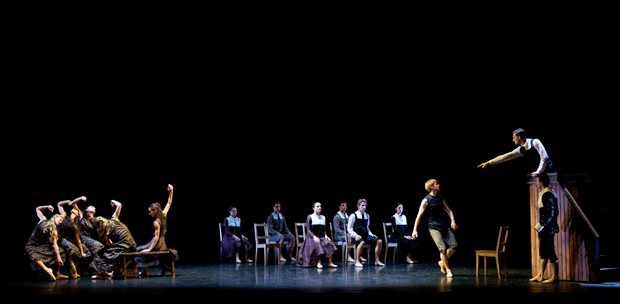
© Andy Ross. (Click image for larger version)
Scottish Ballet
Ten Poems, The Crucible
Glasgow, Theatre Royal
25 September 2014
www.scottishballet.co.uk
Scottish Ballet’s new double bill features ballets by experienced choreographers about two not-so-different communities: small-town Wales in Christopher Bruce’s Ten Poems (by Dylan Thomas) and narrow-minded Salem in Helen Pickett’s one-act version of Arthur Miller’s 1953 play, The Crucible.
Bruce chose to set his 20-minute work, made for Ballet Kiel in 2009, to a 1955 recording of Thomas’s poems by Richard Burton. Though Bruce has used the lyrics of songs before to inspire his choreography, this is the first time in a mature work he has relied on the spoken word alone. Burton’s sonorous Welsh-accented delivery makes the verses sound even more musical than Thomas’s own voice. The dancers can follow the rhythms without being caught up in the meaning (often double-meaning) of the words. So, apparently, could a German-speaking audience.

© Andy Ross. (Click image for larger version)
Yet Bruce has selected the imagery in the ten poems as well-springs of gesture and characterisation, conjuring up imagined village life along the lines of Llareggub in Under Milkwood. He starts with a narrator figure (Andrew Peasgood) embodying the poet lamenting the labour and loneliness of his ‘craft or sullen art’. Then others join him in recollections of boyhood happy (Fern Hill) and cruel (The hunchback in the park). Boys are braggards, girls playful in long blue skirts and sunny tops. Specific characters emerge: Thomas’s dying father (Chris Harrison); the vagrant hunchback (Jamiel Laurence); Eve Mutso as a mourning woman, sharing her grief with two blonde lookalikes; Erik Cavalleri as a disreputable roisterer (Lament) brought to heel by a Sunday wife.
What Bruce doesn’t investigate is the harsh Nonconformism that Thomas deplored. Instead, he turns the bible-blighted ‘boys of summer’ into a brave band of soldiers suffering in battle (And death shall have no dominion). He simplifies the congested language and sentiments of the poems into easy-on-the-eye vignettes, just as Burton’s recital tends to over-romanticise Thomas’s nostalgia. The choreography flows in arcs of movement, its shapes and phrases clearly defined, while Thomas’s language is densely clotted. In the end, the dance reduces the poems rather than distilling them, coming off a distracting second best.

© Andy Ross. (Click image for larger version)
Helen Pickett almost succeeds in distilling Miller’s four-act play into a 40-minute ballet, though you need to know the play to identify the cast of (too many) characters. Pickett is a Brooklyn-based American who started her career as a dancer, spending over a decade with William Forsythe’s Frankfurt Ballet before acting with The Wooster Group in New York. She has choreographed for many companies, including Scottish Ballet last year. Her stagecraft in The Crucible is skilled, combining a cinematic approach to story telling with an expressive range of movement.
She divides the stage into sections, placing the Puritan congregation and their hellfire preacher to one side while key characters dance out their dilemmas in a separate space. This dual action emphasises the cohesion of the small religious community, recently settled in Massachusetts in the 1600s, and their superstitious fear of deviation. Denunciations of witchcraft are signified by placing a cloth with a symbol of evil on the suspected person – always a woman.
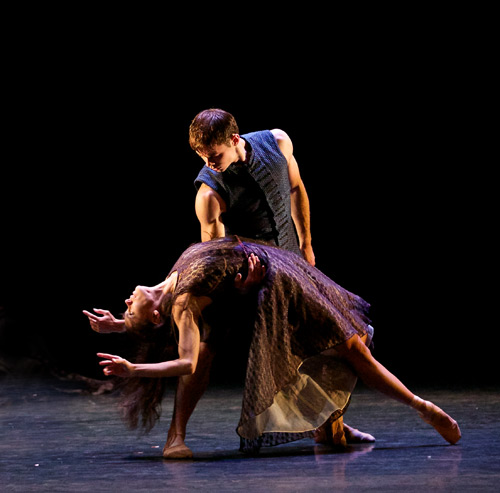
© Andy Ross. (Click image for larger version)
Pickett clarifies the (true) story of the witchcraft trials by spelling out the affair between a young girl, Abigail, and her employer, John Proctor. Abigail is the cause of the havoc that ensues: she wants to get rid of Proctor’s wife, Elizabeth, by whatever means she can – a motive that is only gradually revealed in the play. After a torrid pas de deux between Abigail (Sophie Martin) and Proctor (Chris Harrison), Abigail and her pubescent friends dance a pagan rite in the woods to place a curse on Elizabeth (Eve Mutso). When they are discovered by the preacher, Samuel Parris (Nicholas Shoesmith), accusations of witchcraft made by the hysterical girls become rife.
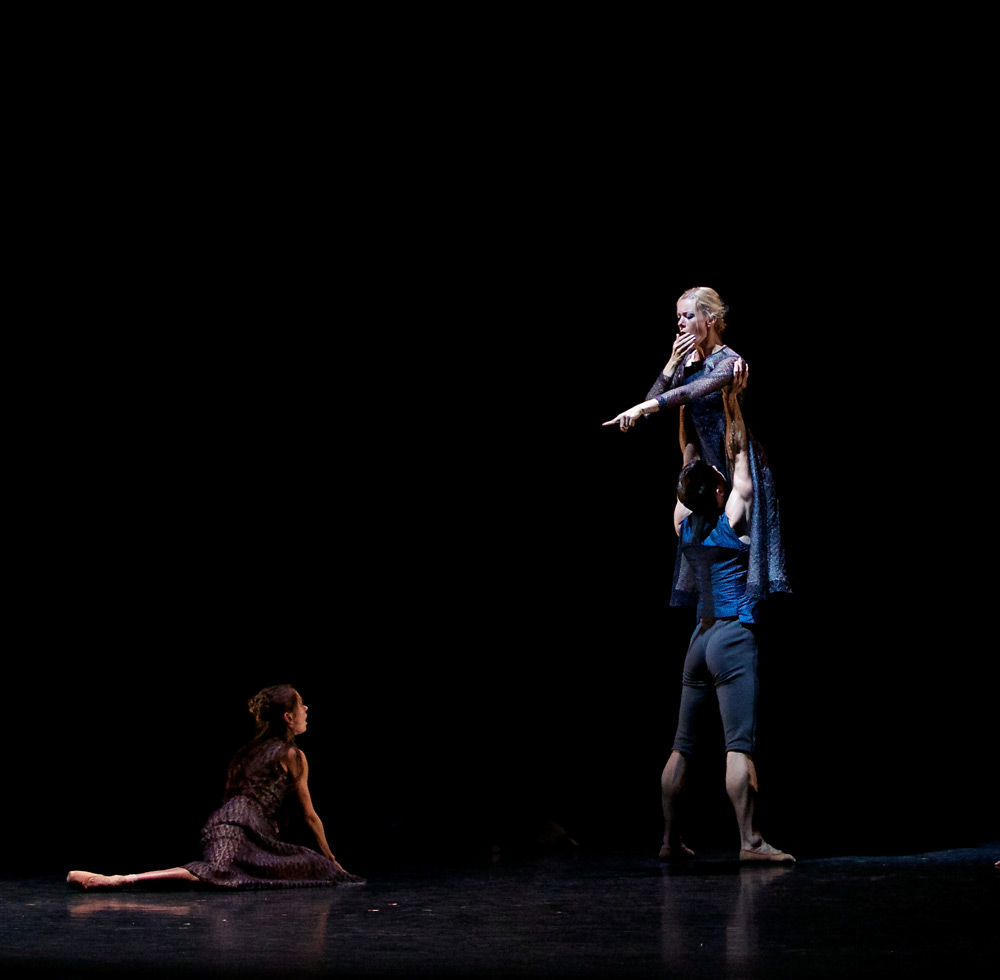
© Andy Ross. (Click image for larger version)
Pickett has to deal with a tricky contradiction. Dancing was regarded by Puritans as an act of the devil – yet this is a ballet with fiendish pointework. So we need to accept that repressed 17th century characters reveal their inner selves through the medium of 21st century dance. After all, the themes of Miller’s play are timeless: obsession, persecution, greed, injustice, crowd hysteria, as well as individual courage and defiance.
Nonetheless, Pickett could make the distinction even clearer between the satanic dancing of the possessed girls and the way otherwise upright members of the community express themselves. Why couldn’t the dancing girls appear naked (or nearly so) as they are supposed to be in Pickett’s synopsis? Instead of being shockingly abandoned, they wear white shifts which they cover with similarly coloured dresses, making them hard to single out later. The pagan priestess, Tituba (Marge Hendrick), a West Indian slave in the play, is indistinguishable in appearance from the other women falsely accused of witchcraft.

© Andy Ross. (Click image for larger version)
Stronger colour-coding for the costumes would assist us bewildered spectators identify named characters in the cast list. Puritan men in white collars and dark outfits look much the same, as do women in bonnets. Once the condemned victims are stripped to their underwear for their trial, they are unrecognisable. Though the dancers know their characters’ back-stories, we’re in the dark. Pickett cannot account for the malice behind the persecution no matter how ably she captures the frenzy of religious mania.
She is helped in racking up the tension by melodramatic music culled from horror film soundtracks (including Hitchcock’s Psycho) and by disorienting electronic contributions from UK music producer Jon Hopkins, who composed the score for Wayne McGregor’s Entity.

© Andy Ross. (Click image for larger version)
Pickett’s choreography for the key roles – Abigail, John and Elizabeth Proctor, Reverend Parris – is graphically telling. Abigail flings herself at Proctor, who can’t resist her; Parris is seduced against his will by the Dionysian rites of the girls in the woods; Elizabeth expresses her remorseful love for her husband in an appealing duet that is almost a stand-alone balletic pas de deux, in contrast to the contemporary dance writhings of their persecutors.
However, the final encounter between Elizabeth and John, leading up to his execution, defeats comprehension. Confusingly, Elizabeth is now in white, with her hair down like one of the bad girls. She has been pardoned for complicated reasons we can’t know about. John’s motives for going to the scaffold for the right reason are far too tortuous for non-verbal expression. The couple grapple agonisingly and he is hanged as the curtain falls. You’ll have to go back to the play to find out why and what happened next.







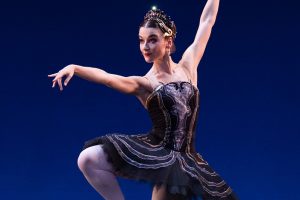



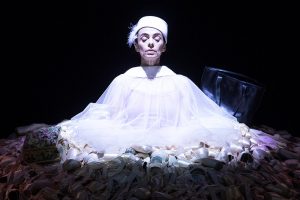
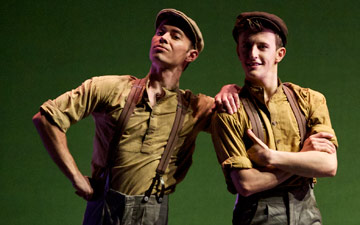

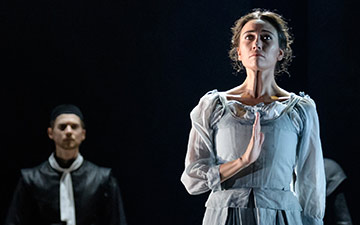


You must be logged in to post a comment.